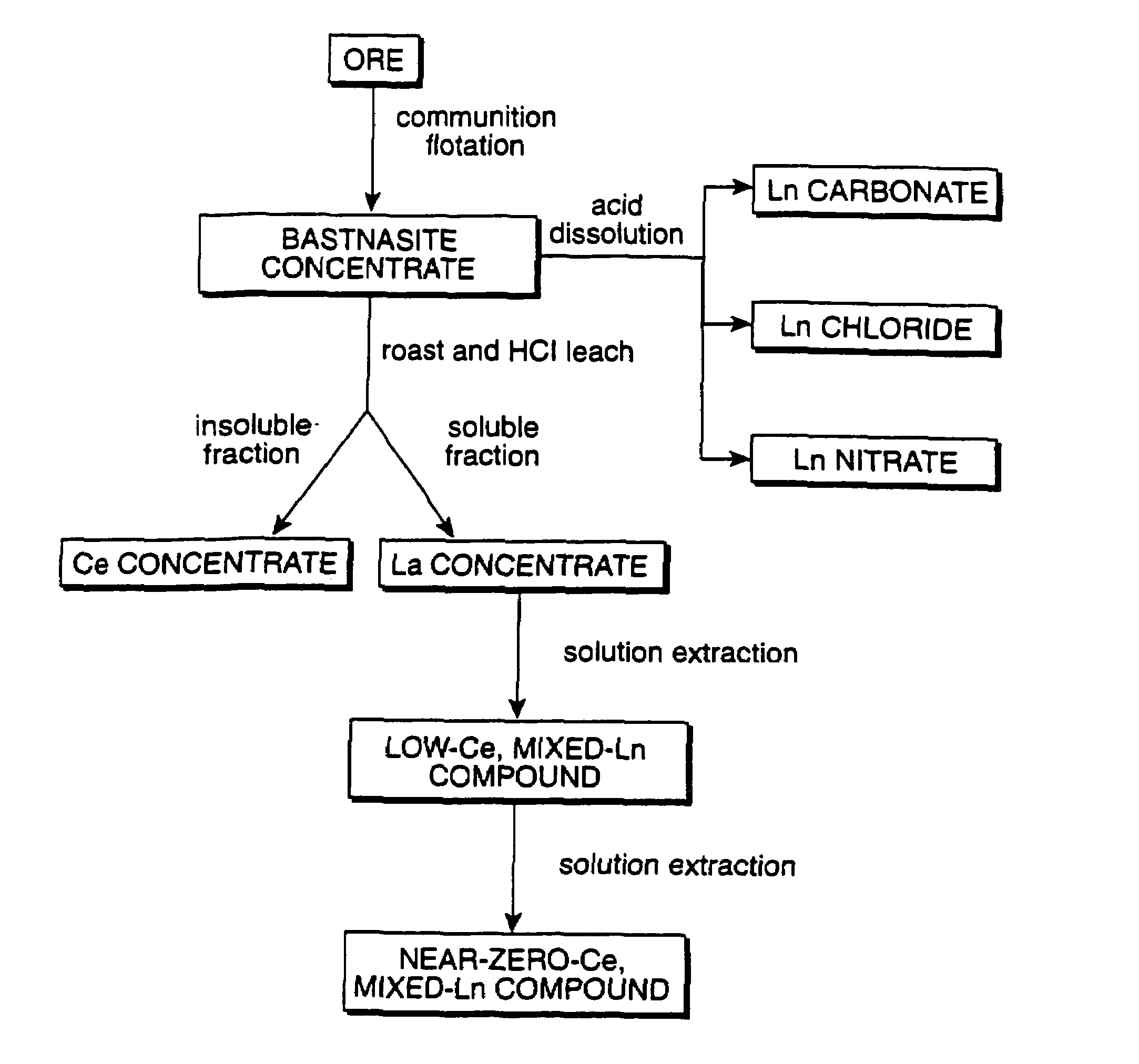Method of controlling emissions from a diesel cycle internal combustion engine with perovskite-type metal oxide compounds
a technology of perovskite-type metal oxide compounds and internal combustion engines, which is applied in the direction of metal/metal-oxide/metal-hydroxide catalysts, arsenic compounds, etc., can solve the problems of high cost, difficult and expensive preparation of individual rare-earth compounds such as individual lanthanides, and high cost of making perovskite-type materials with a single lanthanide on the si
- Summary
- Abstract
- Description
- Claims
- Application Information
AI Technical Summary
Benefits of technology
Problems solved by technology
Method used
Image
Examples
example 1
[0085]A single phase perovskite material of the nominal chemical composition Ln0.6Ca0.4CoO3 was synthesized by dissolving 104.15 g of mixed hydrated lanthanide carbonate, Ln2(CO3)3.4H2O, in a solution formed by dissolving 57.5 g of calcium nitrate tetrahydrate, Ca(NO3)2.4H2O and 177.15 g of cobalt nitrate hexahydrate, Co(NO3)3.6H2O, into 2 liters of water. Intense stirring was used to form a solution of all the components. The mixed lanthanide carbonate hydrate contains La, Ce, Pr and Nd. To this solution was added 200 g of malic acid. The solution was placed in a rotary evaporator and heated by a water bath. The water bath was heated to 90° C. The solution was reduced to 20% of its original volume, and had the consistency of a thick syrup. The syrup was placed into a flat refractory tray and heat treated at 200° C. for 1 hr. The syrup was converted into a solid foam. The foam was then heat treated at a temperature of 700° C. in air for 2 hrs. with an intermediate grind after 1 hr. ...
example 2
[0088]A single phase perovskite material of the same chemical composition as in Example 1 was synthesized by dissolving 104.15 g of mixed hydrated lanthanide carbonate, Ln2(CO3)3.4H2O, in a solution formed by dissolving 57.5 g of calcium nitrate tetrahydrate, Ca(NO3)2.4H2O and 177.15 g of cobalt nitrate hexahydrate, Co(NO3)3.6H2O, into 2 liters of water. Intense stirring was used to form a solution of all the components. To this solution was added 200 g of malic acid. The solution was reduced to half its volume by heating at 80° C. on a hot plate for 3 hrs. The solution was then placed on a refractory tray and heated at 200° C. for 1 hr. The solid foam so obtained was heat treated at 700° C. in air for 2 hrs. with an intermediate grind after 1 hr. The product comprised a black powder of the noted chemical composition and X-ray diffraction analysis showed the material to be a single phase perovskite with a B.E.T. specific surface area of 13 m2 / g.
example 3
[0089]A single phase perovskite material of the same composition as in Examples 1 and 2 was synthesized by grinding and homogenizing 52.08 g of mixed hydrated lanthanide carbonate, 6.83 g of calcium oxide, CaO and 22.82 g of cobalt oxide, CoO. The mixture was heated at 800° C. for 36 hrs. in air with periodic regrinding. The product, comprising a black powder, was characterized by X-ray diffraction as being a single phase perovskite compound with a B.E.T. surface area of 1.2 m2 / g.
PUM
| Property | Measurement | Unit |
|---|---|---|
| atomic number | aaaaa | aaaaa |
| atomic number | aaaaa | aaaaa |
| atomic number | aaaaa | aaaaa |
Abstract
Description
Claims
Application Information
 Login to View More
Login to View More - R&D
- Intellectual Property
- Life Sciences
- Materials
- Tech Scout
- Unparalleled Data Quality
- Higher Quality Content
- 60% Fewer Hallucinations
Browse by: Latest US Patents, China's latest patents, Technical Efficacy Thesaurus, Application Domain, Technology Topic, Popular Technical Reports.
© 2025 PatSnap. All rights reserved.Legal|Privacy policy|Modern Slavery Act Transparency Statement|Sitemap|About US| Contact US: help@patsnap.com



